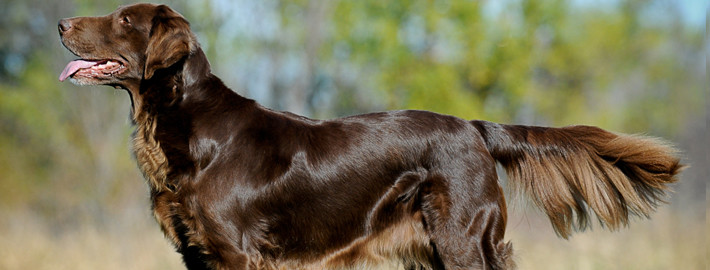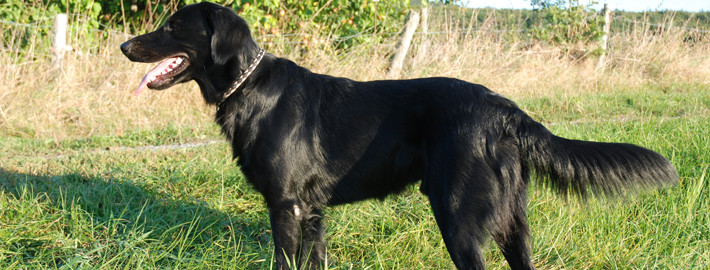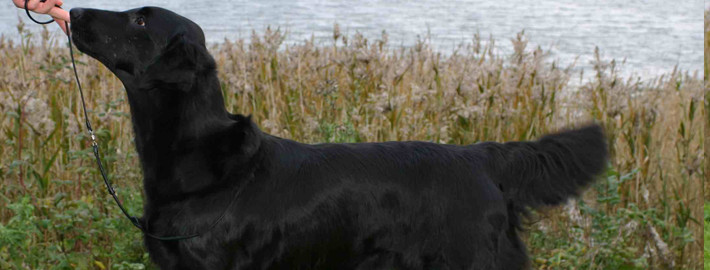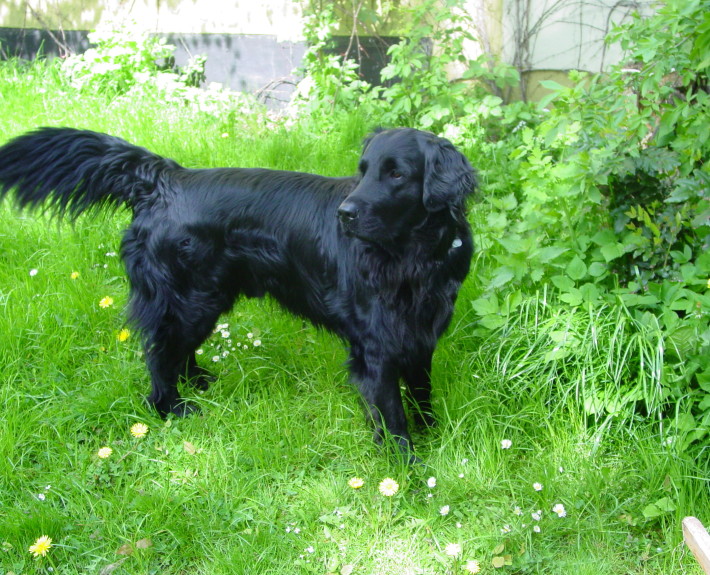What makes the Flat-Coated Retriever Unique?
“Power without lumber and raciness without weediness” is the traditional description of the flat-coated retriever. It is strong but elegant, never cobby, among the most streamlined of the retrievers. It is slightly longer than tall, of moderate substance. The head is distinctive, long and of “one piece,” all parts flowing smoothly into each other. The gait is ground-covering, smooth and efficient. The coat is thick and flat, of only moderate length, providing protection without adding weight. These attributes have resulted in a versatile and athletic hunter capable of retrieving over land and water. The flat-coated retriever is a sweet, exuberant, lively dog that loves to play and retrieve. It is on the go outdoors, but quiet indoors. This breed is among the most devoted and companionable of dogs, a true family dog. It needs regular exercise to be on its best behavior, however. It is a sensitive breed and very responsive to training. Its hallmark is its wagging tail.
Breed Groups
Page Contents
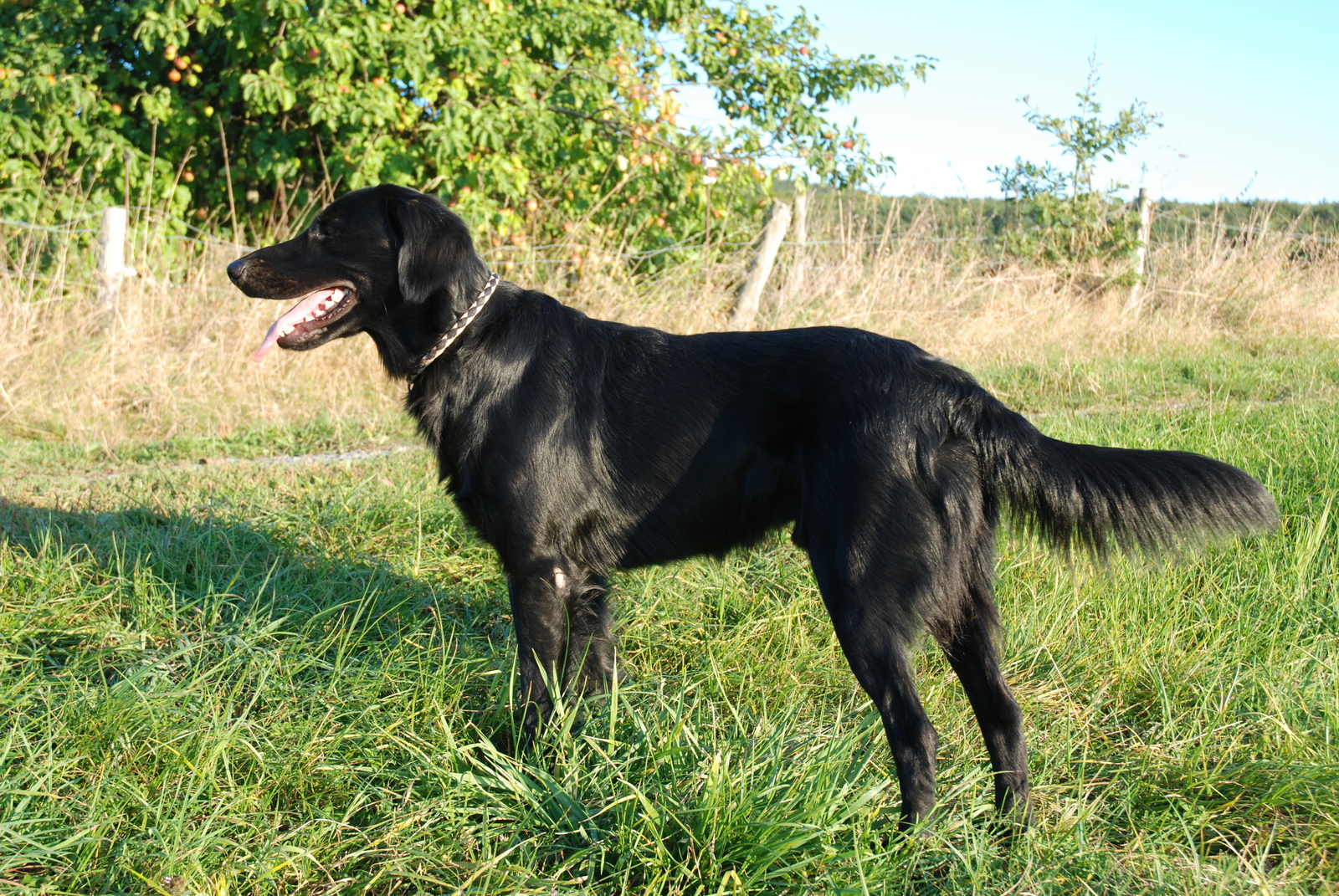
Is the Flat-Coated Retriever Right For You?
Described by all who meet him as cheerful, optimistic and good-humored, the Flat-Coat excels as a family companion. He requires regular vigorous exercise, however, due to his working heritage. Dog sports such as obedience, agility and hunt tests provide both mental and physical exercise. Among Sporting breeds, the Flat-Coat is easy to maintain, needing only occasional brushing and bathing. If you are considering purchasing a Flat-Coated Retriever puppy, learn more. *Sporting Group; AKC recognized in 1915.
*Ideal size: 22 to 24½ inches tall at the shoulder.
*Hunting dog.
In 5 Words
- Alert
- Docile
- Friendly
- Responsive
- Courgeuos
Characteristics
Learn About the Flat-Coated Retriever
Description
The Flat-Coated Retriever is a beautiful sporting dog with a well-proportioned strong body and medium length coat. Boning is moderate; the dog never looks cobby or massive. The neck is strong and slightly arched. The head is long and clean, with a slight stop. The muzzle is deep and strong. The teeth should meet in a scissor bite. The medium size eyes are set wide apart; they are almond shaped, dark brown or hazel in colour. The relatively small hanging ears lie close to the head. The nose is large, with open nostrils. It is black in black dogs and brown in liver dogs.
Flat-Coated Retrievers weigh 60 to 70 pounds, and their height is 22 to 24,5 inches.
Short History of the Flat Coated Retriever
The origin of the Flat Coated Retriever lies in England. This breed dates back to the 19th century. The breed is thought to be a result of crossbreeding between the extinct St. John’s Water Dog, Newfoundland, Setter breeds and Collie-type dogs. The breed was earlier known as a generic Labrador type, before being categorized as a different breed. As with many other breeds, the breed was on the verge of extinction after the Second World War. It began to be replaced by the Golden Retriever, which has its ancestry in the Flat Coated Retriever. However, dedicated breeding programs during 1960s resurrected the breed to a sizeable number. This breed was primarily used as a gundog for hunting small game. It was first recognized by the AKC in 1915.
Temperament
Flat-Coated Retrievers make great family dogs and are excellent companions for children. Smart, active and friendly, they have a very stable temperament. Gentle and playful. This breed is very sociable and needs a lot of affection and attention from its family. Flat-Coated Retrievers literally love everyone including strangers. A lot of vigorous daily exercise is necessary due to their working heritage. Without it, the dog can develop unwanted behaviour. A happy and well-balanced dog seems to always be in good cheerful mood. The owners should display gentle but firm leadership. Even though these dogs are easily trainable, they can get bored without variety. Keep training sessions short and fun, without excessive repetition. Excellent swimmers.
Caring for Your Flat-Coated Retriever
General Health
Flat-coats have a higher risk of cancer than most dogs. Hemangiosarcoma, fibrosarcoma, osteosarcoma and malignant histiocytosis are particularly devastating, and occur at higher rates in Flat-coated Retrievers than in many other breeds. According to studies sponsored by the Flat Coated Retriever Society of America (FCRSA), the average lifespan of the Flat-coated Retriever is only about 8 years, with a high percentage of deaths due to cancer. More recent surveys in Denmark and UK shows a median lifespan of around 10 years. The FCRSA sponsors many university cancer studies and breeders have benefited from increased information on cancer in Flat-coats to reduce the incidence of cancer in future generations.
Flat-coats have a very low rate of hip dysplasia and luxating patellas compared to other medium-sized breeds; the Orthopedic Foundation for Animals (OFA) statistics consistently show a rate of hip dysplasia in the breed of less than 3%. In 1997 FCRSA health survey, 4.2% of males and 3.2% of females had been diagnosed with luxating patellas.
Grooming & Bathing
The medium length coat is sleek, straight and flat-lying. It can be a bit wavy but never curly, wooly, short, silky or fluffy. The legs, tail and chest are well-feathered. Once a week grooming should be fine.
Like Curly-Coated Retrievers, the Flat-Coated variety comes in solid black and solid liver colours.
Exercise & Training
The Flat Coated Retriever is a highly intelligent and trainable dog and makes a wonderful student. This breed is very jolly and energetic so should require consistency, however excessive repetition is sure to bore him and he will quickly lose interest. Discipline is not required, and correction and positive reinforcement work best. Making training fun with a variety of techniques will be sure to keep his attention, and he will excel much further.

